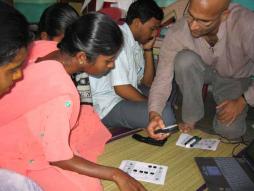livelihoods
Posted by ccarlon on Oct 21, 2011
Information Economy Report 2011: ICTs as an Enabler for Private Sector Development data sheet 687 Views
Author:
Fredriksson, Torbjörn, Cécile Barayre, Scarlett Fondeur Gil, Diana Korka, Rémi Lang, Thao Nguyen, Marta Pérez Cusó and Smita Barbattini.
Abstract:
The Information Economy Report 2011 demonstrates that effective use of information and communication technologies (ICTs) in both the private and the public sector can significantly contribute to and accelerate progress in private sector development (PSD).
Governments and their development partners should take a holistic and comprehensive approach to leveraging ICTs in PSD, although a review of PSD strategies indicates that this is often not the practice. Similarly, donor strategies often refer to the use of ICTs in PSD in a peripheral manner only, if at all. On its own, new technology will have limited effects on PSD. However, when carefully integrated into policies and processes, ICTs can reduce business costs, promote transparent, rules-based systems, and improve communication between the public and private sector.
Governments need to work with the private sector to create an investment climate and a business environment that encourage the use of ICTs within private firms as well as in government. The potential of ICTs can then be realized, through adequate infrastructure and skills, and a commitment by governments to making markets work effectively. In some areas, there is already considerable experience and evidence to guide policy initiatives. In other areas, where opportunities for ICTs to contribute to PSD have emerged only in the past few years (as in the case of mobile money services), more analysis and testing of different business models is needed to assess potential and identify best practices.
Posted by MohiniBhavsar on Oct 12, 2010
Mobile Phones and Development: An Analysis of IDRC-Supported Projects data sheet 2827 Views
Author:
Ahmed T. Rashid and Laurent Elder
Abstract:
In the context of the rapid growth of mobile phone penetration in developing countries, mobile telephony is currently considered to be particularly important for development. Yet, until recently, very little systematic evidence was available that shed light on the developmental impacts of mobile telecommunication. The Information and Communication Technology for Development (ICT4D) program of the International Development Research Centre (IDRC), Canada, has played a critical role in filling some of the research gaps through its partnerships with several key actors in this area.
The objective of this paper is to evaluate the case of mobile phones as a tool in solving development problems drawing from the evidence of IDRC supported projects. IDRC has supported around 20 projects that cut across several themes such as livelihoods, poverty reduction, health, education, the environment and disasters. The projects will be analyzed by theme in order to provide a thematic overview as well as a comparative analysis of the development role of mobile phones. In exploring the evidence from completed projects as well as the foci of new projects, the paper summarizes and critically assesses the key findings and suggests possible avenues for future research.
Posted by MohiniBhavsar on Sep 14, 2010
Mobile Cell Phones and Poverty Reduction: Technology Spending Patterns and Poverty Level Change among Households in Uganda data sheet 265 Views
Abstract:
This paper examines the spending behavior of households with mobile phones in rural agricultureal Uganda and whether such strategies such as substitutions have affected the well-being of these community members. According to the findings, rural households are willing to make sacrifces such as travel expenses and store-bought food budget in order to address the expenses of mobile phone services. While gender inequality through exacerbated asset control and mobile phone inexperience drive further digital divide in this village, the proliferation of small businesses development encourages phone ownership for women. Such strategies to afford a mobile phone or mobile phone services are undertaken to help facilitate long-term asset accumulation. For development studies, the analysis recommends a revised form of development thinking in a growing knowledge economy.
Posted by LeighJaschke on Jul 18, 2009
Blurring Livelihoods and Lives The Social Uses of Mobile Phones and Socioeconomic Development data sheet 1487 Views
Abstract:
This paper focuses on how this intermingling of lives and livelihoods, as mediated
by the mobile phone, figures into the micro-processes of economic development.
It neither broadly elaborates the core contributions of mobile phone use to
economic development (synchronizing prices, expanding markets, reducing transport
costs, etc.), nor suggests that one kind of mobile use is more important than
another. Instead, it argues simply for a perspective on work and on livelihoods that
is broad enough to account for (and perhaps even take advantage of) the social
processes surrounding these activities. Analysts, policymakers, and technologists
interested in the application of Mobiles for Development (M4D) should not
ignore the way mobiles blur livelihoods and lives; the developmental and nondevelopmental uses of the mobile are not in competition, nor are they always distinguishable.
Instead, the uses of mobiles for developmental and non-developmental
purposes are often interrelated and sometimes mutually reinforcing. The social
functions of the mobile (in matters of connection and self-expression) are helping
drive its widespread adoption, and these same functions inform the very behaviors
that make the mobile a tool for economic development.
Posted by LeighJaschke on Jul 14, 2009
The GSMA Development Fund Top 20 Research on the Economic and Social Impact of Mobile Communications in Developing Countries data sheet 3553 Views
Abstract:
The positive implications of landline telecoms infrastructure and, more recently, of mobile communications on
economic growth in the developed world have long been acknowledged, with numerous studies analysing the
issue. Now that most of the developed world has reached high penetration levels of mobile phones, both current
growth patterns and future projections suggest that virtually all of the mobile industry’s new customers in the
coming years will come from developing countries. In fact, as of 2007, there were more mobile customers in
developing countries than in the entire developed world (ITU).
What impact are mobile phones having on developing countries and are user experiences and overall impacts
unique or similar to those of developed countries? While it might seem intuitive to just extrapolate from the results
of earlier studies in developed countries, the developing world is in fact leap-frogging the developed world when
it comes to mobile communication and its many uses. The implications of this technology on daily life in
developing countries appear to be more far-reaching than they were in the earlier developed country rollouts. For
example, studies have demonstrated that mobile technology is driving improvements in social links, the creation
of social capital, improved market information flows and productivity, as well as increases in GDP and Foreign
Direct Investment.
This report surveys recent research and highlights the top studies in this area based on content, relevance,
originality and credibility. While it is not an exhaustive and scientifically developed list, it illustrates the work that
we feel is most important at the moment and highlights key conclusions on the impact of mobile technology in
developing countries.
Further, while the existing research is valuable in understanding the impacts, the literature is still limited in its
coverage and scope. We therefore recommend additional research to expand evidence and knowledge, particularly
with respect to basic economic studies, prospective applications and the needs of users around financial services.
We also call on stakeholders such as mobile operators, governments, industry groups, foundations and
development organisations to play their part in improving information sharing, increasing research and driving
developments in these countries.
Finally, we provide information on additional research on impacts and policy issues, as well.
Posted by Esther Nasikye on Aug 24, 2008
Agriculture is what keeps economies in most developing countries alive. However, farmers in many countries face major challenges. In an age of global markets, they are forced to enhance production, improve the quality of their yield, and access markets within short timeframes. Small-scale farmers especially have traditionally been deprived of weather and crop information, have been at the mercy of middlemen, and have lacked timely market price information to negotiate the best deal. This has chancged with the a connect people advent of widespread telephony that connects farmers wiith markets, weather, and other data.
Governments, non-governmental organisations (NGOs) and international donors are taking advantage of this technology revolution to help farmers access market information. They are convinced that low-cost access to agricultural prices could yield enormous payoffs.
In Uganda, the Women of Uganda Network (WOUGNET), a local NGO, is helping over 400 rural farmers in the Apac District in Northern Uganda, access information on market prices through text messages (SMS).

